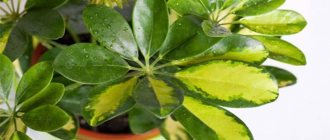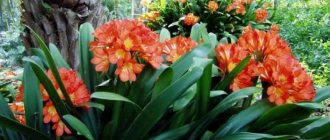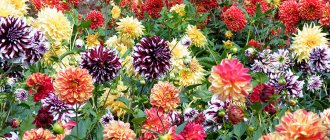Hello, dear friends. Clivia is very popular among lovers of tropical plants. This is a fairly easy to care for and spectacular flower, which has many advantages over other exotic species. Universal love is explained by its unpretentiousness to indoor conditions and beautiful colorful flowering, which usually occurs in the middle or end of winter. Here you will find answers to all questions - what kind of care does Clivia prefer at home, how to propagate and replant the plant, how to cope with diseases and pests.
Propagation of clivia by side shoots
This method of propagating a blooming beauty is the most reliable and simplest. In a pot with an adult plant, over time you can find small sprouts on the sides. These are the “babies” that should be removed from the mother part of the flower when they already have four strong leaves.
The process of planting side shoots must be carried out by adhering to simple but mandatory rules:
- each shoot should have 3-4 leaves;
- the plant can be disturbed only after the end of its flowering period for the current year;
- the “babies” should be separated carefully, taking care to preserve the integrity of the roots of the mother flower system and young shoots;
- accidentally injured roots should be covered with a layer of wood ash in the areas of damage.
The shoots are planted in personal pots 7 cm in diameter. For an adult flower, a small pot is also used. The root system of clivia loves close quarters . With this condition of the roots, the leaves of the flower grow fleshier and richer green.
The first two days after planting, the plant is not watered and kept warm at 20-25 degrees. Then moderate watering is gradually resumed. Young plants will bloom for the first time in 2-3 years.
Reviews from numerous admirers of the homely beauty Clivia
- And my clivia loves when it is rearranged, although it is written everywhere that it cannot stand it. I adhere to watering strictly: twice a week in the summer, once in the winter without overwatering. I use a universal fertilizer for feeding. I think that the dust that accumulates on the leaves is very harmful to the plant, and also looks ugly and faded, so I often wipe them. I planted Clivia with my mother about 6 years ago. I have been enjoying its flowering for 3 years now, but my mother’s plant still hasn’t bloomed. I wonder why?
- Yes, this is just a universal flower! The flowers resemble bells and can be bright red, orange or delicate yellow-white. They do not grow singly, but in whole inflorescences of 30 pieces at once. Although it is not recommended to spray, I still do it. When it blooms, I try not to touch it. As soon as at least one root comes out of the drainage hole, I immediately replant it.
- Girls! My beauty - orange clivia - has blossomed! It’s as if the sun has settled in my house. It is located on my balcony. When it gets very hot in the summer, I bring it into the room. It blooms twice a year.
- About 7 years ago I was given a gift for my birthday. Friends knew my love for flowers and gave me a beautiful clivia. It turned out to be unlike other flowers from my collection. I had to develop individual rules for caring for it: - watering is required only when the soil is dry; - as soon as the peduncle appears, it won’t hurt to water the flower twice with very warm water, at a temperature of +45..+50 °C in order to strengthen it and let it grow higher; - after flowering, 2 weeks later, remove the peduncle and replant it. When replanting, slightly shorten the roots. This simple procedure will ensure the second flowering of clivia in a year. - location plays an important role, I choose only the east side. By the way, 2 times a year, for 20 - 25 days, my favorite pampers with its flowering, and plus there are a lot of children. Due to the variety of varieties, the flowers come in white, yellow, and orange. This sweet shy girl does not require any special conditions. Can do without annual replanting and humid air. If she has a permanent place with windows facing east, as well as an organized rest period, then she will delight you with a cap of bright colors every year.
Seed propagation of plants
To propagate a plant by seeds, the easiest way is to purchase them in a specialized store. If you want to get seeds with your own labor, flowering clivia must be artificially cross-pollinated. To do this, use a thin watercolor brush to take pollen from one flower and carefully place it on the pistil of another flower. Thus, in a blooming clivia umbrella, which has about 60 flowers, half of them will be pollinated, and half will remain a source of pollination.
If the process is successful, then berries will form at the end of flowering. At first they will be light green, and as they ripen they will darken to a brownish hue. Each ripe berry contains 4-5 seeds. This method of propagating clivia gives a guarantee of 1/3 of all flowering specimens received.
What is the difference between clivia and wallota?
Due to the similarity in the shape of flowers and leaves, clivia is often confused with wallot. Despite the fact that both belong to the same family, they differ in individual characteristics. If we take the root system, then the rhizome of the wallot is more similar to an ovoid-elongated bulb than the fleshy similarity of the bulb of clivia. The fan-shaped leaves of clivia are larger in length and width than the leaves of wallot, darker in color, and do not have a longitudinal vein in the center. At the base, the leaves of the wallot are painted in a rich purple color, their ends are rounded. In clivia, the tip of each leaf is pointed, and strokes are visible along the entire length. When a leaf is cut, a yellow-orange juice is released, whereas the wallot does not have this feature. On the peduncle of the wallot there are up to 5 flowers; they are red in color and quite large in size. Small clivia flowers are orange in color with a yellow center; their number on one peduncle reaches up to 30.
Clivia: planting and care (video)
Planting seeds in the soil has preliminary measures and subsequent rules:
- soak the seeds for a day in warm water, leaving them in a warm place to swell;
- plant the seeds in a box with a properly prepared soil mixture, to a depth of 1 cm, at a distance of 2 cm from each other;
- covered with film or glass, creating a greenhouse. provide moderate watering and a temperature of 20-25 degrees;
- If necessary, the seed box is ventilated by removing the greenhouse cover and watered a little.
After 1.5 months, the first shoots will appear. When one strong leaf is formed on each sprout, they are planted in separate pots with soil from the mixture:
- deciduous soil (2);
- clay soil (1);
- humus (1).
Now young flowers are cared for like adults, but they are left with a little more warmth. Clivia from seed develops very slowly:
- The first year - 2-3 new leaves appear.
- Second year – 3-4 pairs of leaves will be added.
- The third year and beyond - 2 pairs of new leaves per year.
Clivia will bloom for the first time only after 5-6 years.
Clivia blooms twice a year: myth or reality?
When the clivia has finished blooming, it is taken out into the open air, to a shady, windless place. The desire to get flowering for the second time in a year forces flower growers to resort to the following trick:
- The plant is allowed to rest for 2-3 months, taken to a dimly lit place, and watering is practically stopped (1-2 times a month).
- As a result of these harsh measures, its dark green leaves turn slightly yellow, but after approximately 1 month the appearance of a peduncle is observed.
Remember: only mature, strong, healthy plants are involved in such experiments.
Reproduction technology by dividing the bush
This method is applicable at the time of transplantation. In this case, the root system is divided into equal parts, and the cut areas are covered with a layer of charcoal. The plants are placed in pots filled with the correct soil mixture and not watered for the next three days. Then resume modest watering. The soil should dry out well between each watering.
Flowering of clivia, propagated by dividing the bush, will resume only after a few years.
Transplanting clivia at home. When and how often should I do this?
Clivia is an elegant and stylish indoor plant that is very unpretentious and, under favorable conditions, delights with its flowers year after year. Its leaves with a lush halo surround a bouquet of inflorescences of bright, joyful tones.
Clivia usually blooms in the last third of winter and wonderfully brightens up snowy, cold days with a piece of summer greenery and flowering. After a certain time, the clivia will need to be transplanted. The clivia roots are carefully removed from the soil and transferred to a new pot, covered with fresh soil, since the old one is already depleted. Next, we will talk in detail about how to plant clivia at home.
Recommended soil mixtures and growing conditions
The soil in the clivia pot should be loose and slightly acidic. The best mixtures would be:
- turf soil (2) + humus (1) + peat (1);
- turf soil (1) + peat (0.5) + sand (1);
- turf soil (1) + leaf soil (1) + humus (1).
Clivia loves light and warmth, but leaving her in the hot sun is destructive. It is better to place a flower pot on the windowsill of an east or west window. On the south side of the house, clivia must be protected from direct sunlight at midday. In summer, it is useful to take the flower out into the garden or onto the balcony, leaving it there in the fresh air in partial shade.
Possible problems
The reason for this is mechanical injury to the root system or deepening of the root neck. When buried, the plant thus normalizes the ratio of above-ground and underground parts.
With a mechanical injury, the process no longer has a corrective effect, but acts as an indicator of a painful phenomenon. In this case, you can water it with Zircon. Echinacea extract concentrate, a powerful antioxidant, acts as an antimicrobial factor and a biostimulant at the same time. This drug is used only in cases of urgent need. You can find out about other possible problems when growing clivia and how to deal with them here.
Propagation of clivia by seeds (video)
Watering clivia should be moderate so that the soil has time to dry out well. If water collects in the pan during watering, it must be drained to avoid root rotting. You should not spray the flower. But when the leaves become covered with dust, they are carefully washed with a soft, damp sponge.
Clivia is fed every two weeks from the moment it is in the pot. For this purpose, use organic and mineral fertilizers for indoor leafy plants, strictly observing the dosages indicated on the packaging.
The resting period of Clivia lasts from September to November. During this period of time, the flower is placed in a cool place and watering is completely stopped. In this case, the leaves may turn yellow and fall off, which is a natural process of overwintering the plant.
Diseases and pests
Clivia rarely, but still encounters diseases and pests. The danger for the tropical beauty is:
- Scale insects are aphids covered with a protective shield. The adult insect is motionless, but the larvae crawl across all the leaves. At the same time, dark spots-growths appear on the leaves. To treat, you need to wash the flower with soapy water. Remove adult specimens with a damp soapy cotton swab. Then the clivia is thoroughly sprayed with an insecticide.
- Mealybugs look like pieces of white cotton wool on the leaves. If there are few pests, it is enough to remove them with a damp swab. If there is a lot, you need to use insecticides weekly until complete recovery.
- Rot - the leaves turn yellow, the plant dies. The damage begins from the roots, so it is necessary to remove the damaged roots and treat the cut with crushed coal. Then they are transplanted into new calcined soil.
As you can see, clivia is not too fussy and grows easily on our windowsills. See you again, friends.
Klabukova Tatyana
Possible problems in development and ways to solve them
If you take proper care of your clivia, it will feel great. But it happens that clivia leaves dry out, turn yellow or become stained, trying to signal errors in its maintenance:
- The leaves dry out and wrinkle, indicating overdried soil. We must not forget about watering the flower.
- Rot spots on the leaves, their yellowing and falling off during the active state of the plant, indicate excess moisture in the roots. To save the flower, it urgently needs to be transplanted into a new substrate and henceforth do not exceed the permissible watering and allow the soil to dry well.
- Dry spots on the leaves are sunburn on clivia. The flower must be removed from direct summer sunlight, which burns it.
A little history
In fact, the secret is simple. Despite its exotic roots and difficult climate in its homeland, clivia is very unpretentious and easily adapts to living conditions in an apartment. Almost the only requirement of the plant that the gardener is recommended to fulfill is to try to touch and disturb the plant as little as possible. The less stress Clivia has, the healthier and calmer the flower feels, delighting the owner with bright and very early flowering, sometimes even up to twice a year. I suggest you familiarize yourself with some botany facts related to the clivia plant.
Growing from seed
Propagating clivia using seeds is a rather painstaking method. Seed material is obtained only from mature plants. How can you plant clivia without leaves? Using seeds that need to be sown in a mixture of river sand, turf and peat. In about 6 months or less, each seed will hatch. It is necessary to sow in autumn, winter or early spring. The container with seedlings should be in a warm room, the soil should be moist. When the first leaves appear, young clivias need to be planted in separate cups. Experienced gardeners quickly germinate clivia from seeds in a warm room in a damp cloth, gauze or napkin. When the seeds in the cloth hatch, they can be planted in cups. After a couple of months, when the young clivias grow up, they need to be transplanted into large glasses and into nutritious soil, the same as for adult bushes. In a couple of years, the bushes need to be replanted three times; they do not need a rest period, so they will quickly gain green mass and a root system. Young plants need to be fed regularly and kept in a room with a temperature of approximately 20 degrees. When a flower is propagated using seeds, the first flowers can be seen after 4 years.
Popular types and varieties
Clivia grows wild on the west coast of South Africa. Wild specimens grow quite tall and powerful. Indoor varieties are inferior to them in size, but not in beauty. Several types of clivia are grown at home.
Cinnabar (miniata)
The most common for home growing. The stems reach a length of 50-70 cm. The leaves are sword-shaped, dark green, tapering towards the apex. The inflorescences are large, reaching a length of 50 cm. One peduncle can contain 10-20 inflorescences. Clivia cinnabar has become the basis for the development of many breeding varieties that differ in size and color of flowers.
Gardena
This species was first identified by R. Garden in the city of Kwazal. The plant grows up to 50 cm in length. The leaves are long, up to 4 cm wide. The peduncles are tall, bearing up to 16 bell-shaped red-orange flowers with lanceolate-shaped petals. Flowering period - autumn-early winter.
Beautiful
A miniature variety of clivia, about 30 cm high. The leaves are dark green, sword-shaped, tapering towards the top. The peduncle is thick, 30-50 cm high. It bears up to 60 tubular flowers of a pale red, orange hue. At the top the petals are greenish and pointed. The plant blooms in the second half of winter.
Description of the houseplant Clivia
Clivia blooms every year if it is properly watered and not left in a warm room for the winter.
It needs a lot of space, and in winter it needs to be given a rest period in a cool room with very limited watering. Clivia does not like to be disturbed - they touch her too much and move her from place to place. Clivia is a very long-lived plant; under appropriate conditions, it can live up to 40 years. Old plants growing in tubs are not replanted, but only fertilized with fertilizers. The best specimens from old plants form up to 40-50 peduncles. The leaves of the plant, the decorative effect of which can decorate your interior even without flowering, are collected in a rosette and arranged in a kind of fan. The bright, cheerful orange inflorescences of clivia, set off by shiny dark green foliage, are extremely beautiful. Clivia flowers bloom in winter. Currently, various varieties of clivia have been bred: from light ocher to dark red flowers with a whole range of warm orange and yellow tones.
Clivia is a genus of perennial evergreen herbaceous plants of the amaryllis family (Amaryllidaceae). Botanist John Lindley named the genus in honor of the Duchess of Northumberland Charlotte Clive, governess of the future Queen Victoria of Great Britain. The genus Clivia includes approximately five species of plants in the amaryllis family.
Evergreen perennial herbaceous plants, stemless, multi-flowered. The leaves are vaginal, tightly covering each other, forming a false stem, linear or xiphoid. Under the ground, clivia develops a rhizome, to which thickened leaf bases and the leaves themselves are attached. Clivia is sort of in the middle between bulbous and rhizomatous plants. The flowers are bell-shaped, red or orange, collected in an umbrella.
One of the most common is Clivia miniata (lat. miniatus - painted with cinnabar, covered with red paint from lat. minium - cinnabar or red lead) - a perennial herbaceous plant of the genus Clivia of the Amaryllis family. In greenhouse and indoor culture it is used as a flower- and foliage-decorative potted plant. The plant's homeland is South Africa.
In the literature it is found under Russian names: orange clivia (matte red, meerkotsvetnaya, red lead), or kaffir (Cape).
Characteristics of clivia
The most common variety in home floriculture is Clivia cinnabar.
- Although it belongs to the Amaryllis family, it produces rhizomes instead of the bulbs characteristic of the family.
- The flower has no stem: evergreen leaves grow on top of each other, resembling a fan. The number and size of foliage depend on age: a 14-year-old has up to 24, length - up to 70 cm, width - up to 7 cm.
- An inflorescence with a diameter of up to 20 cm on a high peduncle (up to 30 cm) can consist of 12-26 flowers (deep orange with a yellowish base with a diameter of up to 8 cm), each with six petals arranged in two rows.
- 40 years is the age of a long-lived clivia, subject to all the nuances of cultivation.
Which method is more effective?
The effectiveness of various propagation methods depends on the desired result.
If it is necessary to obtain a large number of young plants, and the timing of flowering does not matter, choose seed propagation. On the contrary, if you need to get flowering young plants in small quantities, you need to propagate clivia vegetatively. Propagation of clivia by children is simpler and less labor-intensive .
As a rule, children bloom already in the 2nd year after separation from the adult specimen. But clivias don’t have that many lateral shoots, so you shouldn’t count on getting a lot of young plants through vegetative propagation.
It is difficult to propagate clivia by seeds , since in order to obtain them, it is necessary to pollinate the flowers of the plant.
But each fruit contains a large number of seeds, so there will be no shortage of young plants. True, they grow very slowly and bloom only in the 4th year.











